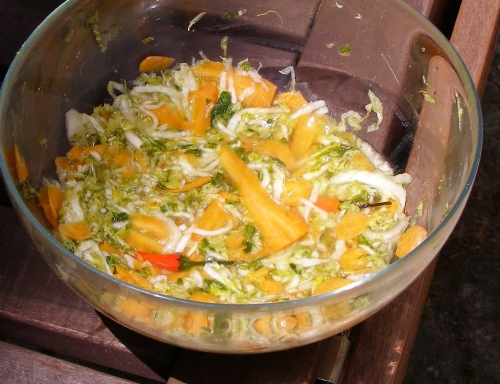
Last week I moved from my little cottage in San Francisco, and for two weeks before the move, our cottage stunk of rotten, moldy towels. It would be easy to imagine that the stench was due to a damp towel forgotten in a dark corner of my bathroom during the in the craziness of moving and quitting my job, but truth be told, the stench was emanating from a dish on the top of fridge. I was making sauerkraut.
I’d read that home-made ‘kraut elevated even bland, rubbery dogs and their Heinz-made, generic accompaniments to something worth craving. Clearly I love my dogs, and since I wasn’t about to attempt this forecemeat dish from start-to-finish, I settled on testing out sauerkraut.
The recipe is simple. I modified it from this site:
1. Boil utensils and crock pot (or glass dish as I used) to sterilize.
2. Slice/chop cabbage and mix with salt at a ratio of 1 1/4lbs cabbage to 1 tbs of salt.
3. Mix thoroughly as the salt will draw water from the cabbage, creating its own brine. If there is not enough brine, mix 1 quart of water with 1 tbs of salt to made additional brine and add to the cabbage. (I needed no extra brine)
4. Once cabbage is ready and the brine has formed, lay a thick plastic bag across the surface of the kraut and then place a plate (sized to rest on top of the sauerkraut) and weights (tins of food work well) on top of the plastic. This weight will ensure the sauerkraut stays submerged in its brine, keeping it from molding.
5. Ferment from 1-4 weeks depending on the temperature in your kitchen. Aim for a 65-75 degree kitchen. I fermented for two weeks at about 75 degrees.
I followed the directions, adding sliced organics carrots and two arbol peppers for some kick, yet my kitchen stank.
Two weeks later, when the smell was unbearable, we headed up to Sonoma for a weekend away and decided on grilling–the perfect chance to test the sauerkraut. As I was unsure that my ‘kraut was even edible, I found another “live” sauerkraut at Whole Foods and discovered a jar of Safeway brand in the back of my ‘fridge–enough ‘kraut for a taste test.

While the stench of the fermented sauerkraut was overpowering, the flavor was divine. It struck a nice balance between, tart, funky and salty with a satisfying crunch that store-bought brands miss. In comparison, the Safeway sample tasted blandly of vinegar. You’d never have guessed that there was cabbage in the jar of lank, beige strips. The “live” Alexander Valley Gourmet Sauerkraut was so salty it could have been mistaken for seaweed–far from lust-worth. The home-made condiment was the clear winner though I’m not sure how often I can test my boyfriend’s patience with a stinky house.
Read Full Post »





